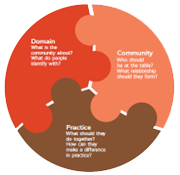Introduction to CoP
A Community of Practice (CoP) is a group of people who share a concern or passion for something they do and improve through regular interaction. The concept, introduced by Jean Lave and Etienne Wenger in 1991, describes how individuals engage in collective learning within a shared domain—such as artists, engineers, students, or professionals exploring new ideas and solving problems.
While the idea of connecting people through shared practice has long existed, organizations have increasingly recognized CoPs as valuable tools for fostering both explicit and tacit knowledge, promoting learning, and enhancing performance. CoPs contribute to organizational resilience by supporting continuous development of individuals and groups.
Ultimately, CoPs are powerful mechanisms for collaboration, bringing together diverse perspectives and enabling groups to learn and work creatively, thereby harnessing collective intelligence to improve overall outcomes.
Structure of a CoP
To understand how CoPs support social learning and how to cultivate them effectively, it is helpful to consider their three interdependent structural elements—Domain, Community, and Practice. These components work together like parts of a jigsaw puzzle, each distinct but essential to the whole.

1. Domain
The domain defines the area of capability that unites the community, gives it identity, and frames the key issues members address together. It reflects what members care about and often relates to specific professions, roles, or interdisciplinary capabilities.
2. Community
A CoP’s progress depends on its members—their composition, relationships, trust, and shared understanding. Long-term engagement and voluntary participation foster commitment and initiative. Depending on the focus, members may be from a single profession or represent diverse perspectives relevant to a shared issue.
3. Practice
Practice grounds the community’s learning in the real-world experiences of its members. As practitioners, members shape learning around lived challenges, exchanging knowledge and co-developing solutions. This includes technical skills, tacit knowledge, personal and interpersonal insights, and awareness of organizational dynamics. Learning is inseparable from the learners themselves and their context.
When domain, community, and practice are aligned, a CoP becomes a powerful force for both individual and collective progress. The domain provides shared focus, the community fosters engagement, and the practice ensures learning is rooted in real work and experience.

